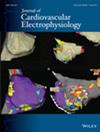Efficacy of the peak frequency map for left atrial posterior wall isolation
Abstract
Introduction
Complete isolation of the left atrial posterior wall (LAPW) is challenging owing to overlapping epicardial conduction. Peak frequency (PF) is a novel parameter that focuses on near- and far-field electrogram components. In this study, we aimed to determine whether transmural block completion is related to the ablation site PF.
Methods
We analyzed 44 consecutive patients undergoing initial LAPW isolation (LAPWI) between June 2023 and February 2024. Pre-LAPWI and PF maps were obtained using an HD-Grid catheter. In 17 of the 44 patients (Group-1), LAPWI was performed conventionally. In the remaining 27 patients (Group-2), PF-guided LAPWI was applied based on Group-1 results.
Results
In Group-1, the left atrial (LA) roof and floor line success rates were 58.8% and 76.5%, respectively. The average PF value in the roof lines of patients with a completed block line was significantly higher than that of the remaining patients (286.6 ± 29.3 Hz vs. 236.1 ± 40.9 Hz, p = .012), but the floor lines were similar. In Group-2, relatively high PF values were targeted to achieve complete block of the LA roof and floor lines, following the results obtained in Group-1. The LA roof line success rates (92.6% vs. 58.8%, p = .007), total number of radiofrequency (RF) applications (22.7 ± 5.6 vs. 27.6 ± 8.5, p = .03), and procedural time (32.6 ± 18.3 vs. 47.9 ± 25.6 min, p = .03) differed between Group-1 and Group-2.
Conclusion
Using a PF map for determining the optimal ablation line for LAPWI by RF catheter ablation is feasible.

 求助内容:
求助内容: 应助结果提醒方式:
应助结果提醒方式:


